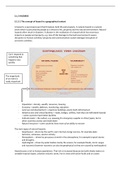3.1.5 HAZARDS
3.1.5.1 The concept of hazard in a geographical context
A hazard is a perceived event that threatens both life and property. A natural hazard is a natural
event which is perceived by people as a threat to life, property and the natural environment. Natural
hazards often result in disasters. A disaster is the realisation of a hazard which has enormous
impacts on people and property, e.g. loss of life/ damage to the built environment/ severe
disruption to human activities/ property and communication system damage/ disruption of
economic activities.
Can’t respond to
something that
happens very
quickly.
The magnitude
of an event is
really important.
- Population = density, wealth, resources, housing
- Economy = wealth, defences, monitoring, education
- Land use and development = expensive buildings, poorly built infrastructure
- Infrastructure and critical facilities = roads, bridges, utilities, how they can withstand hazards
– some countries have better facilities
- Cultural assets = the culture, e.g. queuing for emergency supplies in china/ japan, but in
other countries society can break down
- Natural resources = some countries have more of an ability to recover
The main types of natural hazards:
- Geophysical – driven by the earth’s own internal energy sources, for example plate
tectonics, volcanoes, seismic activity.
- Atmospheric – driven by processes at work in the atmosphere, for example tropical storms
and droughts.
- Hydrological – driven by water bodies mainly the oceans, for example floods, storm surges
and tsunamis (however tsunamis can also be geophysical as they are caused by earthquakes)
Hazards pose a risk to human populations. That risk is increased because we build shanty towns on
unstable tropical slopes, urbanise volcanic zones, live in areas with active faults and on coasts
, susceptible to hurricanes and tsunamis. The problem is also exacerbated by the failure to recognise
a potential hazard and act accordingly.
Natural hazards, and their effects on people, tend to have the following common characteristics:
- Their origins are clear and the effects that they produce are distinctive, such as earthquakes
causing buildings to collapse.
- Most natural hazards only allow a short warning time before the event (some hardly at all)
- Exposure to the risk is involuntary, although this only really applies to the populations of less
well-developed countries. In developed areas, most of the people who occupy hazardous
areas are often well aware of the risks, which they choose to minimise or even ignore.
- Most losses to life and damage to property occur shortly after the event although the effects
of natural hazards can be felt in communities long after that time (disease, disruption to
communications and economic activities).
- The scale and intensity of the event requires an emergency response.
Risk and vulnerability
- Risk is the exposure of people to a hazardous event presenting a potential threat to
themselves, their possessions, and the built environment in which they live.
- Vulnerability to physical hazards means the potential for loss. This varies over space and
time.
o High vulnerability – potential loss is high.
o Low vulnerability - potential loss is low.
Mitigation = reducing the risk.
Geographic
context –
physical setting,
Risk proximity e.g. Biophysical
subduction vulnerability
zone (of the
environment)
END
START: DECISION:
Hazard Place
potential vulnerability
Social
vulnerability
– wealth,
Social fabric – education,
Mitigation experience, age
perception, built
environment,
what people are
like e.g. old/young
Model of vulnerability of one place
People consciously put themselves at risks from natural hazards for the following possible reasons:
- Hazards events are unpredictable – we cannot predict the frequency, magnitude or scale of
a natural hazard event.




